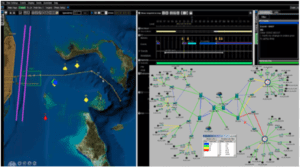CAN-ROUTE
Stottler Henke worked on a research project for the Office of Naval Research (ONR) that investigated developing an innovative software tool that automatically enhances network routing and management of Naval network traffic. This was to be performed by leveraging known network priorities per Commander’s Intent and then determining how best to assure the delivery of mission-critical traffic.
Stottler Henke developed the prototype tool, called the Context Aware Network Routing Optimizer with Understanding of Topology Evolution (CAN-ROUTE). Stottler Henke built upon current powerful solutions, including:
- ViPER, an interactive planning, scheduling, and display system for maritime assets, partially developed by Stottler Henke
- Stottler Henke’s Aurora scheduling system, and
- OPNET tools.
This combination was augmented to handle the complex and diverse conditions found in tactical networks in order to robustly react to emerging/unforeseen conditions via an intelligent awareness of the network state so that network policies, e.g., Quality of Service (QoS), meet the Commander’s prioritization.
The following list provides some background to the model and analysis of CAN-ROUTE:
- DTCN and legacy core Navy networks use priority queuing to provide differentiated services to different applications.
- End-user applications, which may or may not be mission-critical, have DSCP QoS markings.
- End-user applications may be part of different missions. Commanders may alter the priorities of their missions (and the requirements for the apps).
- Application traffic is encrypted before entering the core network.
- Since HAIPEs can be configured to bypass the DSCP settings, higher priority assigned to application traffic is retained in black core.
The most direct beneficiary for the results of this effort is the military tactical networking community, including the US Navy. The prototype of CAN-ROUTE already demonstrates the potential benefits of greater visibility of Commander’s Intent and network resource allocation based on the intent whereby higher-priority information flows more efficiently.

CAN-ROUTE Visualization and Network View